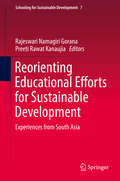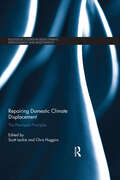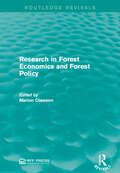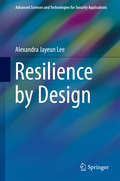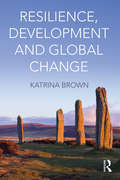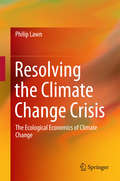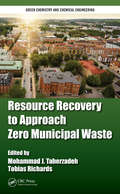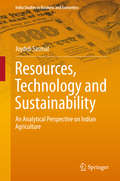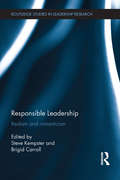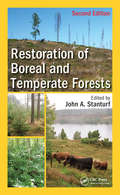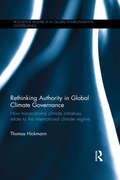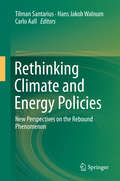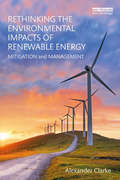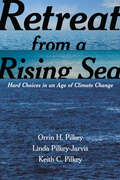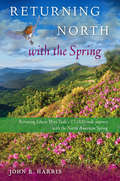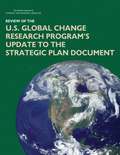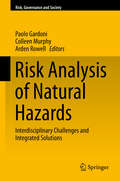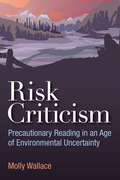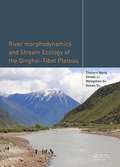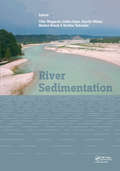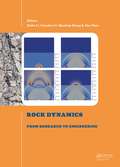- Table View
- List View
Reorienting Educational Efforts for Sustainable Development
by Rajeswari Namagiri Namagiri Gorana Preeti Rawat Rawat KanaujiaEducation in South Asia has a renewed agenda which can enable societies to leapfrog development that is sustainable such that the individual is prepared for his/her involvement, responsibility and commitment to local and global discussions of our common future. This book on South Asia will focus on initiatives under the Education for Sustainable Development (ESD) umbrella and discuss the challenges, opportunities, issues and strategies in the countries of the region. It presents these initiatives of Environmental Education/ESD vis-à-vis the administrative, economic, social, cultural and ecological realities of each country at various levels of policy, planning, implementation and evaluation. The discussions in this book extend beyond formal education systems like schools, higher education, pre-service and in-service teacher preparation to community education and education initiatives conceptualized with the goal of sustainability. All initiatives will demonstrate how each country in its own pace contributing to move ESD from the periphery to the core of education initiatives.
Repairing Domestic Climate Displacement: The Peninsula Principles (Routledge Studies in Development, Displacement and Resettlement)
by Scott Leckie Chris HugginsClimate change, sometimes thought of as a problem for the future, is already impacting people’s lives around the world: families are losing their homes, lands and livelihoods as a result of sea level rise, increased frequency and intensity of storms, drought and other phenomena. Following several years of preparatory work across the globe, legal scholars, judges, UN officials and climate change experts from 11 countries came together to finalise a new normative framework aiming to strengthen the right of climate-displaced persons, households and communities. This resulted in the approval of the Peninsula Principles on Climate Displacement within States in August 2013. This book provides detailed explanations and interpretations of the Peninsula Principles and includes in-depth discussion of the legal, policy and programmatic efforts needed to uphold the standards and norms embedded in the Principles. The book provides policy-makers with the conceptual understanding necessary to ensure that national-level policies are in place to respond to the climate displacement challenge, as well as a firm sense of the programme-level approaches that can be taken to anticipate, reduce and manage climate displacement. It also provides students and policy advocates with the necessary information to debate and critique responses to climate displacement at different levels. Drawing together key thinkers in the field, this volume will be of great relevance to scholars, lawyers, legal advisors and policy-makers with an interest in climate change, environmental policy, disaster management and human rights law and policy.
Research in Forest Economics and Forest Policy (Routledge Revivals)
by Marion ClawsonIn order to fill a growing need for research into forestry issues, Resources for the future held a symposium in 1977.Orignally published in the same year, all papers in this collection were written specifically for this symposium to highlight the most important forestry issues including pricing policy, supply and demand and the role of the public and private forestry sector. This title will be of interest to Environmental Students and professionals.
Resilience by Design
by Alexandra Jayeun LeeThis book discusses that disasters, whether natural or man-made, are essentially a human phenomenon. When a city becomes gridlocked and its resources depleted, the collective resilience of those who remain on the ground becomes critical to its immediate survival and recovery. The author argues that in order to build resilient futures for our urban environment, we need more than the skills of architects, engineers, and planners. Support of local communities and policymakers is also needed. The book revisits the recent catastrophic events: the earthquakes in Port-au-Prince and Christchurch, and the hurricane in New Orleans, and places emphasis on the social, cultural, and political processes of rebuilding houses, facilities, and infrastructure that often go unnoticed. Understanding the wider context for how a built project comes to be, the author argues, is a solid indicator of its longevity than by the measure of its material characteristics alone, and gives us reasons to question the validity of our intentions as designers of the future. This book provides strategies for thinking about, assessing, and developing ways for place-makers from all disciplines to become responsible citizen designers of our cities.
Resilience, Development and Global Change
by Katrina BrownResilience is currently infusing policy debates and public discourses, widely promoted as a normative goal in fields as diverse as the economy, national security, personal development and well-being. Resilience thinking provides a framework for understanding dynamics of complex, inter-connected social, ecological and economic systems. The book critically analyzes the multiple meanings and applications of resilience ideas in contemporary society and to suggests where, how and why resilience might cause us to re-think global change and development, and how this new approach might be operationalized. The book shows how current policy discourses on resilience promote business-as-usual rather than radical responses to change. But it argues that resilience can help understand and respond to the challenges of the contemporary age. These challenges are characterized by high uncertainty; globalized and interconnected systems; increasing disparities and limited choices. Resilience thinking can overturn orthodox approaches to international development dominated by modernization, aid dependency and a focus on economic growth and to global environmental change – characterized by technocratic approaches, market environmentalism and commoditization of ecosystem services. Resilience, Development and Global Change presents a sophisticated, theoretically informed synthesis of resilience thinking across disciplines. It applies resilience ideas specifically to international development and relates resilience to core theories in development and shows how a radical, resilience-based approach to development might transform responses to climate change, to the dilemmas of managing forests and ecosystems, and to rural and urban poverty in the developing world. The book provides fresh perspectives for scholars of international development, environmental studies and geography and add new dimensions for those studying broader fields of ecology and society.
Resolving the Climate Change Crisis
by Philip LawnThis book explains why the climate change crisis is a symptom of a much larger underlying problem - namely, humankind's predilection with continuous GDP-growth. Given this starting point, the world's high-income nations must begin the transition to a qualitatively-improving steady-state economy and low-income nations must follow suit at some stage over the next 20-40 years. Unless they do, a well-designed emissions protocol will be as useless as the paper it is written on. Adopting an ecological economic approach, this book sets out why we must abandon the goal of continuous growth; how we can do so in a way that improves human well-being; what constitutes a safe atmospheric concentration of greenhouse gases; and what type of emissions protocol and emissions-trading framework is likely to achieve a desirable climate change outcome. Failure of the world's leaders to achieve these goals will not only put future human well-being at risk, it will threaten freedom in the liberal-democratic tradition and international peace.
Resource Recovery to Approach Zero Municipal Waste (Green Chemistry and Chemical Engineering)
by Mohammad J. Taherzadeh Tobias RichardsCurrent development results in a linear flow from raw material to waste, which cannot be sustainable in the long term. Plus, a global population of 7 billion people means that there are 7 billion waste producers in the world. At present, dumping and landfilling are the primary practices for getting rid of municipal solid waste (MSW). However, this waste contains resources that we’ve yet to utilize. To create sustainable societies, we need to approach zero waste by recovering these resources.There are cities and countries where zero waste is close to becoming a reality. Landfilling of organic waste is forbidden in Europe, and countries such as Sweden, Germany, Belgium, and Switzerland have developed a variety of technologies to recover resources from MSW. Resource Recovery to Approach Zero Municipal Waste explores the solid waste management laws and regulations of different countries, comparing the latest resource recovery technologies and offering future perspectives. The book tackles the many technical, social, ecological, economical, and managerial aspects of this complex subject while promoting the development of sustainable societies to achieve a greener global environment.
Resources, Technology and Sustainability
by Joydeb SasmalThis book uses sound theoretical frameworks and econometric techniques to rigorously analyze and explain the conditions of sustainable growth in agriculture. It further investigates how management of natural resources and technological advances can enhance productivity and ensure sustainable growth in agriculture. Optimal control theory, dynamic optimization problems and theory of risk and uncertainty are extensively used to create theoretical models for analyzing agricultural growth. The results demonstrate that crop diversification, rainwater harvesting and the use of organic fertilizers can ensure growth in agriculture from a dynamic perspective. Further, they show how excessive depletion of ground water, intensive farming and overuse of chemicals in connection with the adoption of modern technology in agriculture have placed tremendous strains on natural resources like land and water, and have called into question the sustainability of growth in the farming sector.
Responsible Leadership: Realism and Romanticism (Routledge Studies in Leadership Research)
by Brigid Carroll Steve KempsterIt is time for the development of a new kind of business leadership. Global needs call for a revision of market capitalism and a move towards moral capitalism; a move "from value to values, from shareholders to stakeholders, and from balance sheets to balanced development" (Kofi Annan). With the challenge of this transition in mind, this book argues that it is time for a new understanding of leadership, a new romanticism which looks behind the overvalued, heroic leadership notion. The editors explore a romanticized rhetoric and situate it within current discourses of authentic, distributed and ethical leadership, where societal, economic and environmental challenges require us to take a collective lead towards doing good and growing well. Exploring this dichotomy of romantic ideal and essential requirement, this book combines the insights of leading academics and with those of practitioners in the field. Thought-provoking and engaging it will challenge both thinking and practice, and is essential reading for all those operating or researching in the field of leadership, particularly those who realize the overwhelming challenges of sustainability, and corporate social responsibility which the world now faces.
Restoration of Boreal and Temperate Forests (Integrative Studies in Water Management & Land Development)
by John A. StanturfThis substantially updated new edition reflects the growing recognition that large areas of forests are degraded globally. This edition describes forest restoration in the context of rapid social, economic, environmental, and climate change. Covering the last decade's significant advances in forest restoration concepts and practice, this edition has 16 new chapters and 19 thoroughly revised chapters. This book is an excellent source of information for researchers, managers, policymakers, and graduate students in forestry and ecology.
Rethinking Authority in Global Climate Governance: How transnational climate initiatives relate to the international climate regime (Routledge Research in Global Environmental Governance)
by Thomas HickmannIn the past few years, numerous authors have highlighted the emergence of transnational climate initiatives, such as city networks, private certification schemes, and business self-regulation in the policy domain of climate change. While these transnational governance arrangements can surely contribute to solving the problem of climate change, their development by different types of sub- and non-state actors does not imply a weakening of the intergovernmental level. On the contrary, many transnational climate initiatives use the international climate regime as a point of reference and have adopted various rules and procedures from international agreements. Rethinking Authority in Global Climate Governance puts forward this argument and expands upon it, using case studies which suggest that the effective operation of transnational climate initiatives strongly relies on the existence of an international regulatory framework created by nation-states. Thus, this book emphasizes the centrality of the intergovernmental process clustered around the United Nations Framework Convention on Climate Change (UNFCCC) and underscores that multilateral treaty-making continues to be more important than many scholars and policy-makers suppose. This book will be of great interest to students and scholars of global environmental politics, climate change and sustainable development.
Rethinking Climate and Energy Policies
by Tilman Santarius Hans Jakob Walnum Carlo AallThis book calls for rethinking current climate, energy and sustainability policy-making by presenting new insights into the rebound phenomenon; i. e. , the driving forces, mechanisms and extent of rebound effects and potential means of mitigating them. It pursues an innovative and novel approach to the political and scientific rebound discourse and hence, supplements the current state-of-knowledge discussed in the field of energy economics and recent reports by the Intergovernmental Panel on Climate Change. Building on central rebound publications from the past four decades, this book is divided into three main sections: Part I highlights new aspects of rebound economics by presenting insights into issues that have so far not been satisfactorily researched, such as rebounds in countries of the Global South, rebounds on the producer-side, and rebounds from sufficiency behaviour (as opposed to rebounds from technical efficiency improvements). In turn, Part II goes beyond conventional economic rebound research, exploring multidisciplinary perspectives on the phenomenon, in particular from the fields of psychology and sociology. Advancing such multidisciplinary perspectives delivers a more comprehensive understanding of rebound's driving forces, mechanisms, and policy options. Part III puts rebounds into practice and presents several policy cases and sector-specific approaches, including the contexts of labour markets, urban planning, tourism, information and communication technologies, and transport. Lastly, the book embeds the issue into the larger debate on decoupling, green growth and degrowth, and identifies key lessons learned for sustainable development strategies and policies at large. By employing such varied and in-depth analyses, the book makes an essential contribution to the discussion of the overall question: Can resource-, energy-use and greenhouse gas emissions be substantially reduced without hindering economic growth?
Rethinking Creative Cities Policy: Invisible Agents and Hidden Protagonists
by Allan Watson and Calvin TaylorIn recent years, there has been high level of interest amongst policy-makers in the ‘creative city’ concept, due to the anticipation of economic and social benefits from a growing cultural and creative economy. However, a lack of understanding of local social and economic contexts, as well as the complexities and challenges of cultural production, has resulted in formulaic, ineffective misguided policies. This book is concerned, in various ways, with developing an understanding of the complex dimensions of cultural production, and with tackling the often weak and implied links between research, policy and urban planning. In particular, contributors are concerned with agents, protagonists and practices that appear to be somehow invisible to, hidden from, or indeed ignored in much contemporary creative cities policy. Drawing on case studies from the UK and the Netherlands, chapters consider creative industries and policy across a range of scales, from provincial cities and regional economies, to the global cities of London and Amsterdam. This book was originally published as a special issue of European Planning Studies.
Rethinking the Environmental Impacts of Renewable Energy: Mitigation and management
by Alexander ClarkeRenewable energy is important as a substitute for finite fossil fuels and inflexible nuclear power and could conceivably power the world. However, this is challenging as the world is currently 80% dependent on fossil fuels, and renewable sources produce only about 15% of total energy. Conversion technologies for use with many of the eight different primary sources of renewable energy are only just emerging as viable technologies. While renewable energy sources will not run out, and their use involves little or no release of carbon dioxide or ionising wastes, they do have local environmental impacts of their own. This book analyses the nature of environmental impacts from renewable sources. A novel method of assessing impacts is explored based on a set of parameters centred on how diffuse or concentrated the energy flow is. The approach that is developed will inform engineers, designers, policy makers and planners as well as researchers in the area.
Retreat from a Rising Sea: Hard Choices in an Age of Climate Change
by Orrin H. Pilkey Linda Pilkey-Jarvis Keith C. PilkeyMelting ice sheets and warming oceans are causing the seas to rise. By the end of this century, hundreds of millions of people living at low elevations along coasts will be forced to retreat to higher and safer ground. Because of sea-level rise, major storms will inundate areas farther inland and will lay waste to critical infrastructure, such as water-treatment and energy facilities, creating vast, irreversible pollution by decimating landfills and toxic-waste sites. This big-picture, policy-oriented book explains in gripping terms what rising oceans will do to coastal cities and the drastic actions we must take now to remove vulnerable populations.The authors detail specific threats faced by Miami, New Orleans, New York, and Amsterdam. Aware of the overwhelming social, political, and economic challenges that would accompany effective action, they consider the burden to the taxpayer and the logistics of moving landmarks and infrastructure, including toxic-waste sites. They also show readers the alternative: thousands of environmental refugees, with no legitimate means to regain what they have lost. The authors conclude with effective approaches for addressing climate-change denialism and powerful arguments for reforming U.S. federal coastal management policies.
Retreat from a Rising Sea: Hard Choices in an Age of Climate Change
by Orrin H. Pilkey Linda Pilkey-Jarvis Keith C. PilkeyThis sobering examination of climate-change and the disastrous effects of rising sea levels explains what must be done to avoid the worst outcomes. By the end of this century, hundreds of millions of people living at low elevations along coasts will be forced to retreat to higher and safer ground. Because of sea-level rise, major storms will inundate areas farther inland and will lay waste to critical infrastructure, such as water-treatment and energy facilities, creating vast, irreversible pollution by decimating landfills and toxic-waste sites. Retreat from a Rising Sea explains in gripping terms what rising oceans will do to coastal cities—detailing the specific threats faced by Miami, New Orleans, New York, and Amsterdam. This policy-oriented book then lays out the drastic actions we must take now to remove vulnerable populations. Aware of the overwhelming social, political, and economic challenges that would accompany effective action, the authors consider the burden to the taxpayer and the logistics of moving landmarks and infrastructure, including toxic-waste sites. They also show readers the alternative: thousands of environmental refugees, with no legitimate means to regain what they have lost. The authors conclude with effective approaches for addressing climate-change denialism and powerful arguments for reforming U.S. federal coastal management policies.
Returning North with the Spring
by John R HarrisAt winter's end in 1947, driven by the devastating loss of a son killed in World War II, naturalist Edwin Way Teale followed the dawning spring season northward in an amazing 17,000-mile odyssey from the Everglades to Maine. He wrote about the adventure in North with the Spring. Its sequel Wandering Through Winter won the Pulitzer Prize.Retracing Teale's route, writer John Harris reveals a vastly changed natural world. In Returning North with the Spring, he stops at the very places where Teale once stood, trekking through the Okefenokee wetland, the Great Smoky Mountains, the Great Dismal Swamp, the New Jersey Pine Barrens, and Cape Cod. He is stunned to see how climate change, invasive species, and other factors have affected the landscapes and wildlife. Yet he also discovers that many of the sites Teale described have been newly "rewilded" or permanently protected by the government.Homage to the past, report on the present, glimpse into the future--this book honors what has been lost in the years since Teale's famous journey and finds hope in the small tenacities of nature.
Review of the U.S. Global Change Research Program’s Update to the Strategic Plan Document
by Engineering Medicine National Academies of SciencesThe Update to the Strategic Plan (USP) is a supplement to the Ten-Year Strategic Plan of the U.S. Global Change Research Program (USGCRP) completed in 2012. The Strategic Plan sets out a research program guiding thirteen federal agencies in accord with the Global Change Research Act of 1990. This report reviews whether USGCRP’s efforts to achieve its goals and objectives, as documented in the USP, are adequate and responsive to the Nation’s needs, whether the priorities for continued or increased emphasis are appropriate, and if the written document communicates effectively, all within a context of the history and trajectory of the Program.
Rifts and Passive Margins
by Michal NemčokRifts and passive margins are extremely important for the petroleum industry, as they are areas of high sedimentation and can contain significant oil and gas resources. This book provides a comprehensive understanding of rifts and passive margins as a whole. It synthesises in one volume the existing information devoted to specific aspects of these vitally important hydrocarbon habitats. This collecting together of state-of-the-art information on the topic facilitates the better use of this knowledge to assess the risks of exploring and operating in these settings and the development of systematic and predictive hydrocarbon screening tools. The book will be invaluable for a broad range of readers, from advanced geology students and researchers to exploration geoscientists to exploration managers exploring for and developing hydrocarbon resources in analogous settings.
Risk Analysis of Natural Hazards
by Colleen Murphy Paolo Gardoni Arden RowellThis volume investigates the interdisciplinary and cross-cutting challenges in the risk analysis of natural hazards. It brings together leading minds in engineering, science, philosophy, law, and the social sciences. Parts I and II of this volume explore risk assessment, first by providing an overview of the interdisciplinary interactions involved in the assessment of natural hazards, and then by exploring the particular impacts of climate change on natural hazard assessment. Part III discusses the theoretical frameworks for the evaluation of natural hazards. Finally, Parts IV and V address the risk management of natural hazards, providing first an overview of the interdisciplinary interactions underlying natural hazard management, and then exploring decision frameworks that can help decision makers integrate and respond to the complex relationships among natural events, the built environment, and human behavior.
Risk Criticism: Precautionary Reading in an Age of Environmental Uncertainty
by Molly WallaceRisk Criticism is a study of literary and cultural responses to global environmental risk in an age of unfolding ecological catastrophe. In 2015, the Bulletin of the Atomic Scientists reset its iconic Doomsday Clock to three minutes to midnight, as close to the apocalypse as it has been since 1953. What pushed its hands was not just the threat of nuclear weapons, but also other global environmental risks that the Bulletin judged to have risen to the scale of the nuclear, including climate change and innovations in the life sciences. If we may once have believed that the end of days would come in a blaze of nuclear firestorm, we now suspect that the apocalypse may be much slower, creeping in as chemical toxins, climate change, or nano-technologies run amok. Taking inspiration from the questions raised by the Bulletin's synecdochical "nuclear," Risk Criticism aims to generate a hybrid form of critical practice that brings "nuclear criticism" into conversation with ecocriticism. Through readings of novels, films, theater, poetry, visual art, websites, news reports, and essays, Risk Criticism tracks the diverse ways in which environmental risks are understood and represented today.
Risks, Rewards and Regulation of Unconventional Gas
by Moore Ian G. Grafton R. Quentin Cronshaw Michal C.The global energy transition from carbon-intensive to renewable fuels has increasingly demanded a better understanding of the causes and consequences of the rapid development of unconventional oil and gas. Focusing on key countries including the US, Canada, China, Argentina, the UK and Australia, this book consists of case studies and in-depth analyses that weigh up the risks and rewards at regional, national and global scales. Explaining how and why unconventional fuels are transforming the global energy landscape, the strengths, weaknesses, opportunities and threats are explored through a political, economic and governance-based perspective. Emphasis is placed on how to regulate the industry, encompassing local issues, stakeholder engagement and the social licence to operate. The new baseline studies and standards introduced in this book provide a timely insight into the trade-offs across the social, economic and environmental domains, making this ideal for researchers and policymakers in energy fields, and for graduate students.
River Morphodynamics and Stream Ecology of the Qinghai-Tibet Plateau
by Zhaoyin Wang Zhiwei Li Mengzhen Xu Guoan YuThis book focuses on the river morphodynamics and stream ecology of the Qinghai-Tibet Plateau. The objective of the book is to summarize and synthesize the recent studies based on field surveys undertaken in the period 2007-2014. This book was written to serve as a graduate-level text for a course in river dynamics and stream ecology and as a refer
River Sedimentation: Proceedings of the 13th International Symposium on River Sedimentation (Stuttgart, Germany, 19-22 September, 2016)
by Silke Wieprecht Stefan Haun Karolin Weber Markus Noack Kristina TerheidenSediment dynamics in fluvial systems is of great ecological, economic and human-health-related significance worldwide. Appropriate management strategies are therefore needed to limit maintenance costs as well as minimize potential hazards to the aquatic and adjacent environments. Human intervention, ranging from nutrient/pollutant release to physical modifications, has a large impact on sediment quantity and quality and thus on river morphology as well as on ecological functioning. Truly understanding sediment dynamics requires as a consequence a multidisciplinary approach.River Sedimentation contains the peer-reviewed scientific contributions presented at the 13th International Symposium on River Sedimentation (ISRS 2016, Stuttgart, Germany, 19-22 September 2016), and includes recent accomplishments in theoretical developments, numerical modelling, experimental laboratory work, field investigations and monitoring as well as management methodologies.
Rock Dynamics: Proceedings of the 2nd International Conference on Rock Dynamics and Applications
by Jian Zhao Haibo Li Jianchun Li Qianbing ZhangRock Dynamics: From Research to Engineering is a collection of the scientic and technical papers presented at the Second International Conference on Rock Dynamics and Applications (RocDyn-2, Suzhou, China, 18-19 May 2016). The book has four sections. The first section contains 8 keynote papers, covering a wide range of dynamic issues related to roc
